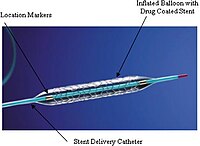
Photo from wikipedia
This review addresses the different aspects of the use of titanium and its alloys in the production of dental implants, the most common causes of implant failures and the development… Click to show full abstract
This review addresses the different aspects of the use of titanium and its alloys in the production of dental implants, the most common causes of implant failures and the development of improved surfaces capable of stimulating osseointegration and guaranteeing the long-term success of dental implants. Titanium is the main material for the development of dental implants; despite this, different surface modifications are studied aiming to improve the osseointegration process. Nanoscale modifications and the bioactivation of surfaces with biological molecules can promote faster healing when compared to smooth surfaces. Recent studies have also pointed out that gradual changes in the implant, based on the microenvironment of insertion, are factors that may improve the integration of the implant with soft and bone tissues, preventing infections and osseointegration failures. In this context, the understanding that nanobiotechnological surface modifications in titanium dental implants improve the osseointegration process arouses interest in the development of new strategies, which is a highly relevant factor in the production of improved dental materials.
Journal Title: Materials
Year Published: 2022
Link to full text (if available)
Share on Social Media: Sign Up to like & get
recommendations!